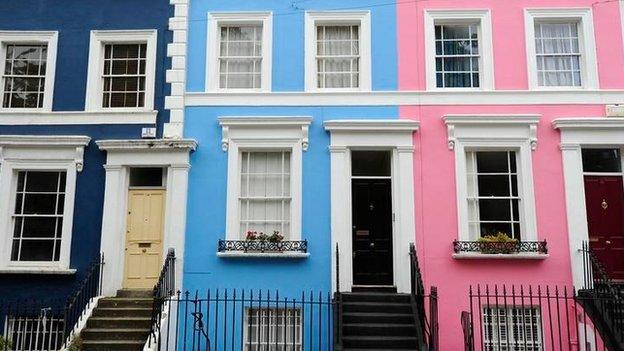UK house prices 'rise 9.9% in a year'
- Published

The Bank of England has various tools that can be used to cool the housing market
House price increases accelerated in April, rising by 9.9% compared with the same month a year ago, according to official figures.
The typical price of £260,000 grew at the fastest rate for nearly four years.
The Office for National Statistics (ONS) said prices rose strongly across the UK, with Wales, Scotland and Northern Ireland all picking up pace.
London, where prices were up 18.7%, remains the driving force behind the housing revival.
But excluding London and the South East of England, the cost of a home was still 6.3% higher than 12 months before.
The governor of the Bank of England said he would take prompt action, if action was needed.
Writing in the Bank's annual report, Mark Carney said: "We will not hesitate to take further proportionate and graduated action as warranted," Carney said. He added that the Bank's Financial Policy Committee, which is meeting today, had announced measures in November to reduce stimulus to the housing market."
Other surveys
In March, the ONS calculated that the annual rate of increase had fallen back slightly to 8%, so the April figures shows the market accelerating once again.
April house price inflation was 10.4% in England, 3.3% in Wales, 4.8% in Scotland and 2.6% in Northern Ireland - all higher than the previous month.
First-time buyers continue to experience more rapid price increases than people moving house.

Business correspondent Andy Verity writes:
A rise in London house prices of 18.7% in the year to April is more than 20 times as fast as the average rise in pay (up 0.9%). Even if you strip out London and the south-east of England, prices nationally are up 6.3%.
We need a reliable measure of what house price inflation is doing to the cost of living. Do we have it? Not exactly. The ONS leaves housing costs out of its Consumer Price Index on the grounds that a house is an asset, not something you consume. But for many people - especially younger people - housing costs are by far their biggest single cost.
The ONS answer until now has been to produce another statistic, CPIH, which includes housing costs. Yet, even as house prices roared away, CPIH didn't rise but actually dropped, from 1.6% to 1.4%.
How? Because it measures owner-occupiers' housing costs by looking at what they would pay if they rented. Not the mortgages people actually pay. And the numbers assume that housing costs make up just 15% of the average expenditure.
But ask young people whether they spend just 15% on housing - and you'll get a funny look. Many older people may have paid off their mortgages. The statistics mask gaping differences between the generations. Perhaps younger people could use an alternative measure of the cost of living that reflects their reality - where housing costs are by far the biggest burden.

'Trapped'
Campbell Robb, the chief executive of Shelter, said: "Each rise in prices means more people stuck living in their childhood bedrooms, or trapped in the cycle of moving from one expensive rented home to the next.
"This is a problem that the government can fix. We need a new generation of quality part-buy, part-rent homes, and to make sure that small builders can get hold of the land and finance necessary to build them.
The ONS reports its figures a month later than other organisations, though the calculation is based on the widest sample of mortgages.
The Halifax has already estimated May's year-on-year increase at 8.7%.
The Nationwide building society said May saw an annual rise of more than 11%, although it suggested that the market might be coming off the boil.
Last week, Chancellor George Osborne announced plans to give the Bank of England the power to impose a cap on home loans related to income or the value of the house.
At present, the Bank can advise on such a cap, but not impose it. The new power should be in place before the end of this Parliament in 2015, the chancellor said.